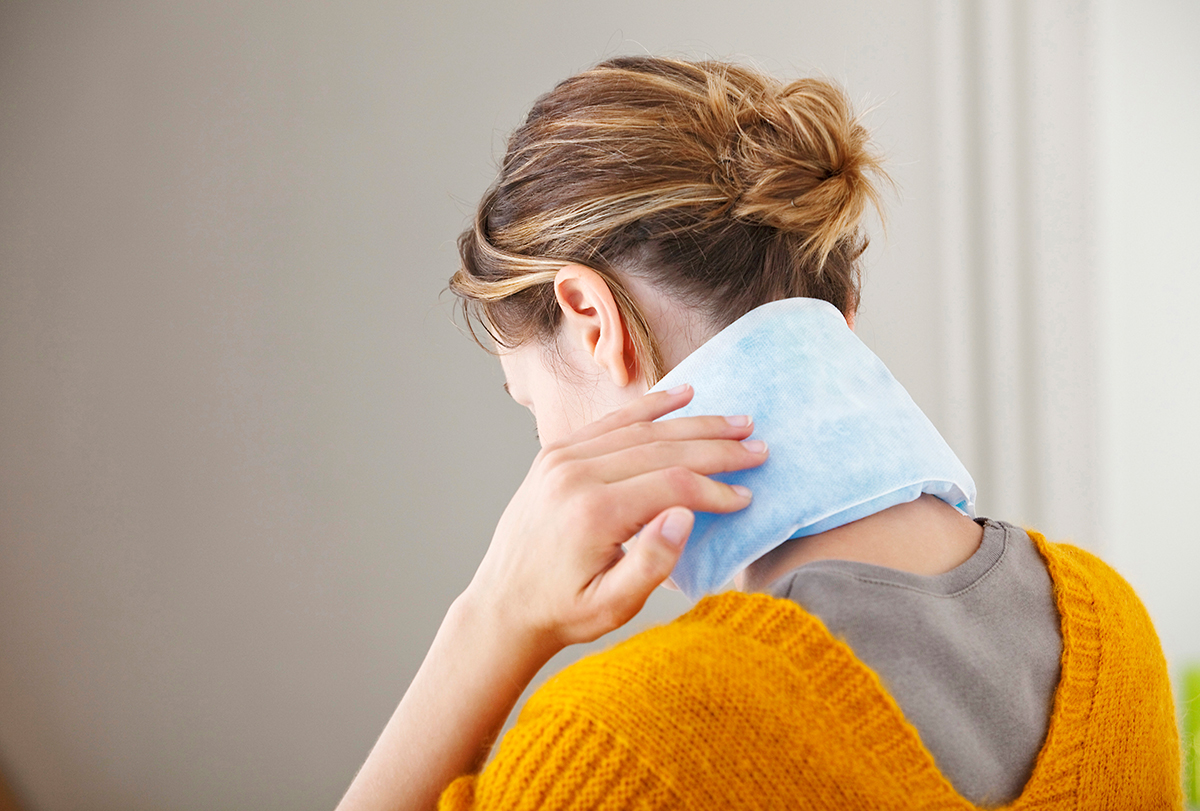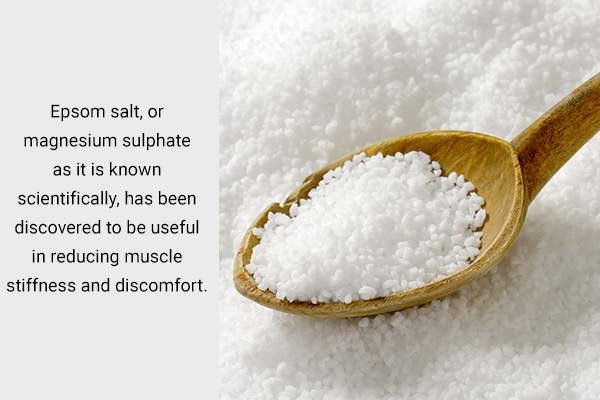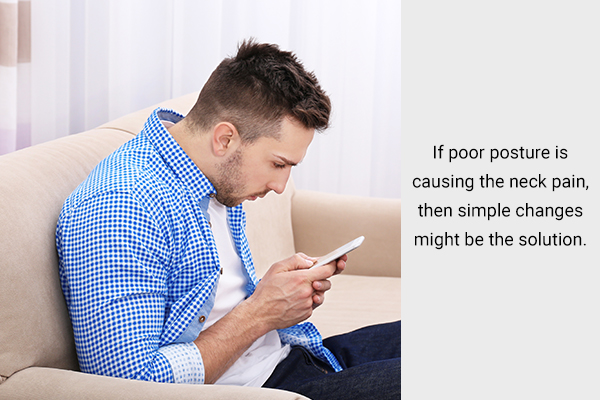In this article:
Neck discomfort is a frequent issue that may be brought on by a number of things, such as bad posture, trauma, or underlying medical issues.

While there are a variety of home remedies that can help with neck pain relief, medical therapy may occasionally be required.
Various practical at-home treatments for neck discomfort will be examined in this article, which you can simply include in your everyday routine.
How to Manage Neck Pain at Home
You may lessen neck discomfort and enhance your general quality of life by adopting a natural and holistic approach.
1. Apply an ice pack
Ice application might act as an anti-inflammatory to lessen pain and swelling. For neck pain, it is preferable to start by applying ice or cold packs because they can momentarily shut tiny blood vessels and stop swelling from getting worse. (1)
After a few days, you can alternate between using heat and ice. Continuously applying heat may result in further swelling.
2. Apply safflower extract
Safflower extract is a natural remedy that has been used for centuries to alleviate pain and inflammation, including neck pain.
Safflower contains compounds called flavonoids, which have anti-inflammatory and analgesic properties. These compounds work to reduce inflammation in the body, which can help alleviate the pain associated with neck pain.
An open-label prospective study showed that applying concentrated safflower extracts to affected areas significantly reduced pain and discomfort in patients suffering from chronic neck pain. (2)
3. Use hot fomentation therapy

It has been well documented that heat reduces pain and increases healing by increasing blood flow to the tissue.
Heat has two benefits. First, it lessens discomfort and, second, it improves circulation. When utilized in a clinical setting, it is frequently repeated two to three times per week in 15-minute sessions.
A randomized controlled trial tested whether the addition of heat therapy improved adherence to a home exercise regimen in people suffering from neck pain. An improved home exercise compliance was demonstrated by the slow continuous heat effect, which would lead to improvements in muscle strength and range of motion. (3)
4. Sleep on ergonomic pillows
Neck pain and other symptoms leading to disturbed sleep might be exacerbated by inadequate pillow support.
A group of scientists reviewed work done on ergonomic pillows. It was found that compared to feather pillows, rubber and spring pillows may perform better. In individuals with persistent neck pain, the use of spring and rubber pillows is useful in reducing neck pain, awakening symptoms, and impairment as well as in improving pillow satisfaction. (4)
The height and design of the pillow may have a considerable impact on cervical alignment. By ensuring that the neck, shoulders, and spine are in alignment, ergonomic pillows may improve the quality of sleep as well as potentially lessen pain.
5. Massage your neck
A massage is frequently used after using ice or heat and can relieve muscle tension and spasms and thus reduces pain.
A randomized controlled trial was carried out to determine if therapeutic massage is better for patients with persistent neck discomfort than a self-care book. According to the study, massage therapy is safe and, at least temporarily, may help cure chronic neck pain. (5)
6. Take an Epsom salt bath

Epsom salt, or magnesium sulfate as it is known scientifically, has been discovered to be useful in reducing muscle stiffness and discomfort, but further research is required to determine the precise mechanism underlying this therapeutic action. (6)
The most common way to employ this natural muscle relaxant is to prepare a relaxing Epsom salt bath for yourself.
How to use:
Fill a tub with warm water, add a couple scoops of Epsom salt, and then immerse your sore body in it.
7. Incorporate these lifestyle modifications
Sometimes, the way you go about your daily routine is responsible for neck pain, and simple modifications can lead to significant pain reduction.
If it is observed that a particular activity causes neck pain that recurs, that activity may need to be restricted or avoided.
To keep the neck more upright while texting, the phone should be held closer to eye level. Moreover, cut down on activities such as spending many hours each day with your neck craning over a smartphone. (7)
8. Perform warmup exercises for the neck
You should warm up your neck muscles with a few quick movements, such as rotating your head, moving your head back and forth, and changing your posture every 30–40 minutes when using a smartphone or an e-reader. Repeat this at least 10 times. (8)
You can also try this warmup exercise:
- Grasp the bottom of your chair with one hand.
- Slightly turn your chin toward your armpit until a comfortable stretch is felt on the opposite side of the neck. Hold that position for 20 seconds.
- Repeat thrice on each side.
9. Posture improvement can help

If poor posture is causing neck pain, then simple changes might be the solution. This could include changing a workstation to become more ergonomically friendly, with the chair, single or multiple monitors, mobile phones, and keyboard positioned in ways to keep the body, head, and neck more aligned in a natural position.
You could also learn to sleep on the back (instead of the stomach or side) with an ergonomically friendly pillow and mattress. (9)(10)
ALSO READ: How to Improve Your Posture to Avoid Back Pain
10. Perform neck exercises
Neck exercises are a great way to provide relief to sore muscles and strengthen them further.
Here’s a simple exercise you can follow:
- Pull back your shoulders and chin for a few seconds at a time.
- Retract the scapula and chin for 20–30 seconds.
- Repeat this exercise 4–5 times a day, especially when working hunched over.
This exercise helps to relieve neck discomfort and postural instability by bolstering the neck’s and the head’s stabilizing muscles. (8)
Most-Asked Questions About Neck Pain
How do I know if my neck pain is serious?
If you are certain that your neck pain was caused by sleeping incorrectly, bad posture, etc., then you can treat it with simple home remedies. However, if your neck pain was caused by an injury in the recent past or if you have other underlying issues, then it might be a good idea to visit a doctor.
When should I be concerned about my neck pain?

You should be concerned about your neck pain when it was caused by an injury or accident or if it has not reduced even after trying some home remedies. It would be a good idea to visit a healthcare practitioner to rule out medical issues.
Can any other issues cause neck pain?
Yes, issues such as excessive gas formation and back pain can also lead to neck pain. (11)
Neck pain can also be caused by somatic depression. If you suspect this, please consult a medical professional at the earliest.
What can I do to treat my neck pain at home?
If you are sure that your neck pain is due to improper posture, incorrect sleeping habits, etc., then you can try the home remedies mentioned above, beginning with hot water fomentation.
You can take paracetamol or use a pain-relieving ointment too.
How do I sleep so that my neck doesn’t hurt?
You can try using a neck pillow that is ergonomically designed to support your head and relieve pressure from your neck. You can also try using multiple pillows to support your shoulders and lower back.
Is there anything I should avoid doing at home?

Avoid engaging in any potentially hazardous activity because you are unable to move your neck, such as cycling or driving. Use a neck collar only when your orthopedic surgeon advises you to do so.
When should I consult an orthopedic?
If there is no improvement in your symptoms even after several weeks or if you have other symptoms such as shivering, a sensation of pins and needles, or cold extremities, you should visit an orthopedic.
Final Word
Neck discomfort is frequently caused by psychological risk factors, including chronic stress, a lack of social support, anxiety, and depression. Neck discomfort may result from specific conditions such as autoimmune illnesses or neuromusculoskeletal problems.
More study is required, but there is also evidence that demographic factors such as age and sex might affect the occurrence and progression of neck discomfort. (12)
There are several home remedies you can try for acute neck pain. In case your pain does not subside or if you suspect that another issue may be causing it, it would be a good idea to visit a doctor to rule out complications.
Home remedies such as using an ice pack, hot fomentation, or Epsom salt baths are easy to do and show quick results. It is a good practice to maintain proper posture and take frequent breaks from long hours of working in one place and keep doing gentle neck movements.
 Continue ReadingNeck Pain: Causes, Symptoms, Diagnosis, and Treatment
Continue ReadingNeck Pain: Causes, Symptoms, Diagnosis, and Treatment
- Was this article helpful?
- YES, THANKS!NOT REALLY


